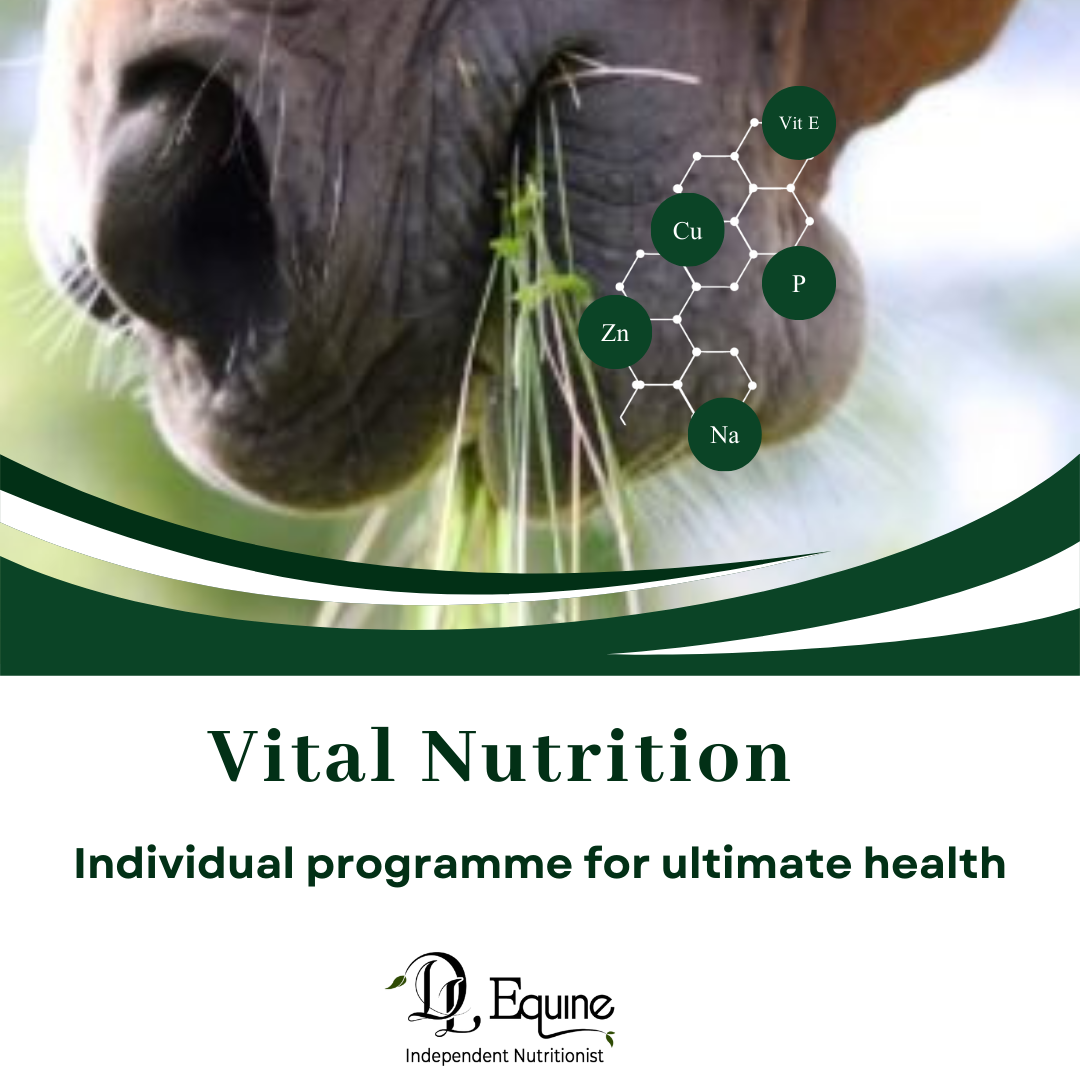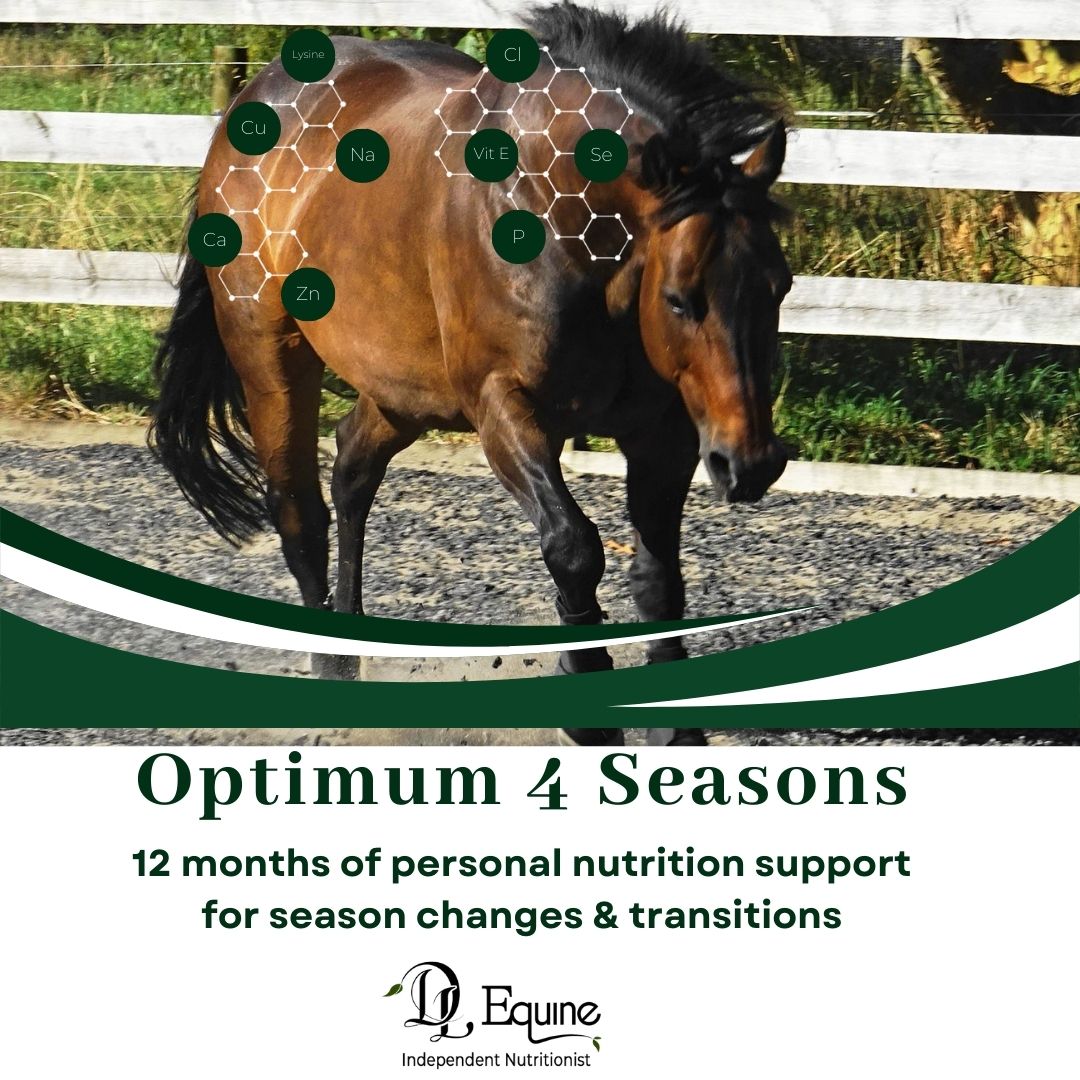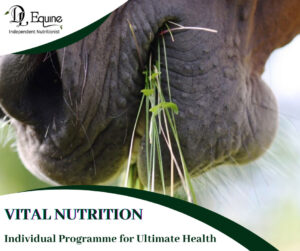What are they?
- Sugars
- Starches
- Fibres
This is a group of sugar-based compounds, also called saccharides, and comprises important energy sources for the horse.
The simplest carbohydrates are monosaccharides (made up of one unit and also called simple sugars), such as glucose, fructose.
Another type of carbohydrate is a disaccharide (two sugars bonded together), which includes lactose (found commonly in milk, made from a unit of glucose and galactose) and sucrose (table sugar, made from glucose and fructose).
There are also oligosaccharides (three to 200 units each) and polysaccharides, or “complex carbohydrates” (each made up of multiple units, typically 200-2,000, which include compounds such as starch and cellulose). Cellulose is considered a type of dietary fiber, along with hemicellulose, lignin, pectins, and fructans.
How do carbohydrates work in horses?
First a horse consumes the carbohydrates found in forages and grains, then the enzymes found primarily in the small intestine break down disaccharides and starch into monosaccharides.
These are then absorbed into the bloodstream, where they are converted for energy or energy storage.
However dietary fibers, such as cellulose, hemicellulose, and pectins, are NOT digested by enzymes, but instead undergo fermentation. These are broken down in the cecum and large colon by the large population of microbes which turn these fibrous carbohydrates into volatile fatty acids. These are used as an energy source by the horse.
What are the issues with feeding carbohydrates in a horse?
Gut problems:
Horse are limited in their ability to digest starch in large amounts. If a horse consumes too much (such as a grain overload), the enzymes in the small intestine cannot cope and undigested starch makes its way thru into the large intestine. The microbes in here are highly sensitive and not used to dealing with starch and this amount makes for an unhappy environment. In turn this causes an overproduction of acids like lactic acid which can result in the horse getting colic.
Laminitis:
It can also result in some of the special microbes dying and releasing toxins into the bloodstream causing lamintis.
Insulin Resistance, Equine Metabolic Issues:
High starch and sugar diets result in an increase in blood glucose concentrations, followed by an increase in insulin concentrations.
Put simply, when your horse eats something with starch the enzymes breakdown the large starch molecules into small glucose pieces. This glucose then leaves the small intestine and enters the bloodstream where it can be used for energy by the body’s cells.
BUT in order to get into cells it needs help to get thru the cell doors. This is where Insulin helps by grabbing the glucose and sending it into cells.
In the horse in Insulin Resistance basically, the cell has no doors to allow the insulin to get the glucose inside and the glucose molecules remain in the blood stream.
Even worse a cascade of effects occurs where the pancreas thinks it needs to send out more insulin to help the glucose get into the cells and so the blood levels of insulin continue to rise along with the glucose!
Eventually the glucose can enter the cells and the blood glucose returns to normal levels but it is slow. And if this situation described above occurs often enough over a long period of time the pancreas cells have to work too hard and may fail, then the blood glucose levels may never return to normal.
Another hormone involved at this stage called ‘Leptin’ which is released by the fat cells and normally will shut off appetite as it permits the uptake of nutrients into the cells. When things go wrong and cells become resistant to leptin, the horse continues to be hungry, continues to eat and leptin continues to be produced at higher levels. This triggers a stress response in the body and suppresses the thyroid. This slows the metabolic rate of the horse.
Both these responses can lead to fat storage or deposits, and the more fat a horse, the more signals are sent to reduce the cell receptors for insulin. Then the more fat produced the higher the insulin levels as the cells become resistant to the insulin. Also, an underweight horse with a high metabolic rate can be insulin resistant and will eventually develop the fat deposits commonly seen along the neck and tailhead.
All this can also lead to Laminitis = weakened laminae attachment in the hoof.
What should I feed my horse if there is a problem?
Different feed types contain different types of carbohydrates; these have implications for the horse’s nutrition and health, in part because of their ability to cause gastric upset.
If your horse has metabolic health issues such as PPID or IR, it is especially important to analyze your feed to determine the carbohydrate fractions within it. The following are key carbohydrate fraction terms you might encounter on a feed tag or pasture/hay analysis:
Nonstructural carbohydrates (NSC) A measure of the easily digestible carbohydrates, including simple sugars and fructans. Horses sensitive to glucose should be fed a low-NSC diet.
Water-soluble carbohydrates (WSC) A measure of water-soluble sugars, including simple sugars and fructans.
Ethanol-soluble carbohydrates (ESC) A measure of ethanol-soluble sugars, including mostly monosaccharides and disaccharides.
Amy Gill, PhD, a private equine nutritionist based in Lexington, Ky., recommends that for sensitive horses, hay total starch and sugar should be below 10% and the total diet below 15%. According to Gill, if a hay analysis is unavailable and the horse is symptomatic, owners can soak the hay (for 30-45 minutes) to help reduce any soluble sugars that might be present.
Do not just think about the NSC component as it is not the best measure when evaluating a horse’s carbohydrate intake. NSC doesn’t give you a complete picture of the types of carbohydrates in a feed or forage that can affect your horse’s condition.
The group of carbohydrates all noted under the NSC tag includes nearly all the non-fiber carbohydrates–those that come from plant cell contents rather than tough, fibrous cell walls. They are generally more easily digestible and yield more energy to the horse than the fiber carbohydrates, but they’re not all digested in the same part of the horse’s gastrointestinal tract or by the same process. Thus, they affect a horse’s blood sugar and gastrointestinal health differently, and this is why it’s important that they be evaluated separately.
Paul Sirois, manager of Dairy One/Equi-analytical Forage Analysis Laboratories in Ithaca, N.Y. explains: “Let’s say one hay sample has 5% simple sugars+starch and 10% fructan, with an NSC value of 15%.
And you have another with 10% simple sugars+starch and 5% fructan that is also 15% NSC.
They’re not the same hay even though they have the same NSC value.
The one that’s 10% simple sugars+starch might be more of a problem for the insulin-resistant horse (because simple sugars and starch, which are primarily digested in the small intestine, cause a greater glycemic or blood sugar response than fructans).
The hay that’s 10% fructan could be more of a problem for a laminitic horse.” (Fructans are primarily digested in the large intestine; large doses can upset the microbial population there, resulting in colic and/or laminitis. Some fructans are in fact used at high doses to induce laminitis in some research situations.)
Instead of looking at NSC, nutritionists are recommending that we evaluate water-soluble carbohydrates – WSC, ethanol-soluble carbohydrates – ESC and starch.
WSC—Simple sugars and fructans, which is simply termed “sugar” on some analyses. Interpreting and using this value depends on the proportions of sugars and fructans in the sample; simple sugars are digested and absorbed in the small intestine and have a significant impact on blood sugar (glycemic response), while fructans are fermented in the large intestine and induce a much smaller response. However, when eaten in large amounts, some fructans have been shown to cause laminitis due to disruption of the bacterial population in the large intestine. Fructans are rarely analyzed separately from other WSC.
ESC–are a subset of WSC that is primarily digestible in the small intestine and includes much fewer fructans. As such, this fraction is generally used to evaluate one set of carbohydrates in a feed that will induce a high glycemic response. Depending upon the lab doing the analysis, WSC and ESC may both be reported as “sugar.” This has caused a lot of the confusion in the industry, notes Sirois. “At Dairy One/Equi-analytical, we no longer report ‘sugar,’ ” he adds. “Carbs are correctly identified as either WSC or ESC.”
What is the desired feed value?
If the values for starch and ESC are low, there will be little glucose available to be absorbed from the small intestine.” This would mean a low glycemic response, which is good for insulin-resistant horses or others that can’t handle large swings in blood sugar levels.
If the WSC and starch values are low, there should be only a small amount of material reaching the large intestine that will be rapidly fermented. Therefore, low starch + low WSC means less opportunity for large intestinal disturbances. This feed would be good for a laminitic horse, particularly one whose disease was initiated by diet-related colic.
The best values are ESC + Starch below 10%.
Dale Logan
BSc, Post Grad Dip, Equine Nutrition, Massey University.
Equine Nutrition Advanced Uni of Guelph, Cert Equine Herbal Medicine, Cert NZ Animal Welfare Legislation
©DL Equine






